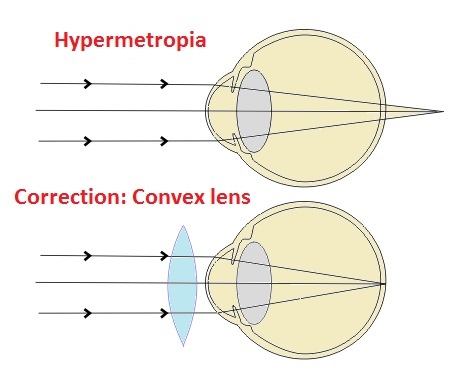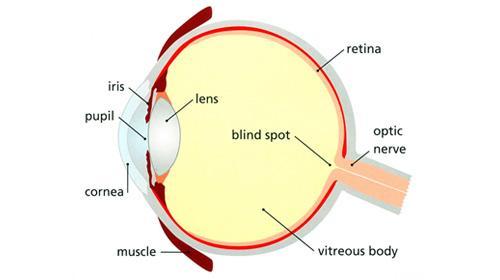8th Grade > Physics
LIGHT MCQs
:
B
Regular reflection is a reflection in which all the incident parallel rays of lightremains parallelafter reflection from the reflecting surface. Incase of concave mirrors, the parallel beam of light is converged to apoint after reflection and hence ceases to be a parallel beam of light. Thus, the reflection is not regular, but an irregular one.
:
B
As your friend is wearing a convex lens to correct his vision, he is suffering from hypermetropia. In this defect, the person is not able to see objects which are near him as the image is formed behind the retina. This is corrected using a convex lens. Convex lens, which is a converging lens, shifts the image onto the retina. The figure below depicts the correction of hypermetropia.

:
C
A plane mirror forms an image which has the same size as the object. Plane mirror does not magnify the image. Therefore, the size ofthe image will also be 10 cm.
:
A
The most comfortable distance at which one can read with a normal eye is about 25 cm. This distance is called the least distance of distinct vision.
:
B
As your friend is wearing a convex lens to correct his vision, he is suffering from hypermetropia. In this defect, the person is not able to see objects which are near him as the image is formed behind the retina. This is corrected using a convex lens. Convex lens, which is a converging lens, shifts the image onto the retina. The figure below depicts the correction of hypermetropia.

:
D
There are two kinds of sensitive cells present in the retina:
(i) Cones, which are sensitive to bright light and
(ii) Rods, which are sensitive to dim light.
Besides, cones are sensitive to colour.
Thus, both the statements in the question are incorrect.
:
B
If the angle of inclination between two plane mirrors is 'x' degrees, the number of images formed, 'n' is given by,
n=360x−1
In case of two parallel plane mirrors, the angle of inclination between them is 0o.
Hence, infinite images would be formed as each image acts as an object for the other mirror.
:
B
Regular reflection is a reflection in which all the incident parallel rays of light remains parallel after reflection from the reflecting surface. In case of concave mirrors, the parallel beam of light is converged to a point after reflection and hence ceases to be a parallel beam of light. Thus, the reflection is not regular, but an irregular one.
:
A, B, and C
The lens focuses light on a layer called retina. Retina has sensory cells that reponds to the incoming light. Optic nerves originate from the retina and carries nerve impulse to the brain for interpretation. At the junction of the optic nerve and the retina, there are no sensory cells, so no vision is possible at that spot. This is called the blind spot.

:
A
Rainbows are formed because of dispersion of light by the water droplets present in the atmosphere. When the white light passes through the water droplets suspended in the atmosphere, it is dispersed into its seven constituent colors which we call as a rainbow.


















